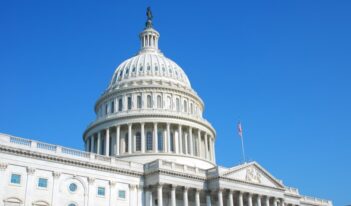
Critics of national injunctions should not stretch the meaning of key words in the APA.
When a lower court decides that an administrative agency is acting unlawfully, may it enjoin the government from engaging in that practice anywhere in the nation, even if this relief would prevent any other lower court from adjudicating the validity of the practice? The question as to when, if at all, a court may proceed in this manner has given rise to lively debate in the courts and among commentators.
In the U.S. Supreme Court’s recent travel ban case, Trump v. Hawaii, a concurring opinion by Justice Clarence Thomas raised serious doubts about the validity of “national injunctions,” as they are sometimes known. Justice Thomas largely based his analysis on professor Samuel Bray’s recent article in the Harvard Law Review, which presented a broad case against the propriety of such injunctions. According to Bray, a lower court should, outside the class action context, grant coercive relief only to the individual litigant who prevails in court.
Both Justice Thomas and Bray base their arguments on a relatively narrow interpretation of the equitable remedial powers of the federal courts. Although I think they are asking the right questions, I am not sure the issue is as one-sided as they maintain. Professor Amanda Frost and other scholars have advanced credible policy arguments that militate in favor of a more receptive attitude toward national injunctions. Still, as such injunctions continue to proliferate, the judicial system needs guideposts for deciding when this type of relief should be allowed, and the Court should soon turn to identifying some.
In a recent review of Bray’s and Frost’s work, professor Jack Beermann agrees that both authors have sound arguments on their respective sides. He then references Section 706 of the Administrative Procedure Act (APA), remarking that, “as an administrative law nut, I wish they both grappled more with the meaning of the APA’s instruction that reviewing courts should ‘hold unlawful and set aside’ unlawful agency action.” That issue is serious, because when the challenged agency action is a rule, a judicial order that “sets it aside” looks equivalent, in practical effect, to an injunction that prevents the rule from applying to anyone. For the benefit of administrative law nuts everywhere, I will attempt to clarify that issue here.
Bray himself has given a firm answer: The APA “does not authorize national injunctions.” The “set aside” language of Section 706 does not persuade him otherwise:
When the APA was enacted the expectation was that agencies would make policy primarily through adjudication, not through general rulemaking….“Set aside” was a technical term for reversing judgments….“Set aside” as a term for reversing judgments, not for giving national injunctions, is exactly what we would expect if Congress were anticipating a norm of agency policymaking through adjudication.
Like professor Christopher Walker, I doubt that this reading of Section 706 can bear scrutiny. Virtually everyone understands “set aside” to connote total nullification of the unlawful agency action. In the context of judicial review of regulations, this means that a rule that is “set aside” no longer applies to anyone. As the U.S. Court of Appeals for the D.C. Circuit has written, “When a reviewing court determines that agency regulations are unlawful, the ordinary result is that the rules are vacated—not that their application to the individual petitioners is proscribed.” Indeed, if this were not so, it is hard to understand how a court could effectively remand a rule to an agency for further consideration. The rule must be either remanded or not remanded—or remanded as to some provisions only, as discussed below.
Moreover, Bray’s historical account overlooks significant evidence that, at the time the APA was written, “set aside” was understood to mean, in a rulemaking context, the same thing as it does today. If we want to understand the expectations of Congress when it adopted the APA, a good place to look would be the 1941 Final Report of the Attorney General’s Committee on Administrative Procedure. President Franklin Roosevelt appointed this committee, staffed by luminaries who included professors Walter Gellhorn and Kenneth Culp Davis, for the very purpose of building a record for Congress to consider as it drafted administrative procedure legislation. Its report played a prominent—though controversial—role in the legislative deliberations. On the subject of judicial review of regulations, the committee wrote:
Some of the recent statutes conferring rule-making power…require that the regulations in question be based upon findings of fact; that these, in turn, be based upon evidence made of record at a hearing; and that a reviewing court set aside a regulation not only for failure of the findings to support it, but also for failure of a finding to be based upon substantial evidence in the record. Review by the courts is had in statutory proceedings which may be instituted within a prescribed time by parties aggrieved by regulations and which result in a certification of the administrative record to the court. A judgment adverse to the regulation results in setting it aside. (Emphasis added.)
Presumably, the committee was referring to laws such as the Urgent Deficiencies Act of 1913 and the Communications Act of 1934. They provided that “orders” could be “set aside” if shown to be unlawful. By the time the APA was enacted, the Court had repeatedly construed these provisions as applicable to orders “promulgating regulations”—in other words, rulemaking. For example, in the 1942 case of Columbia Broadcasting System v. United States, the Court held that networks could go to court directly to challenge the Federal Communications Commission’s regulations on ownership of multiple stations, or “chain broadcasting.” The networks’ challenge was successful: The Court upheld a judicial decree that set aside—completely nullified—the regulations. This interpretation of “set aside” lined up with earlier case law.
In one sense, Bray is correct when he argues that such “setting aside” judicial decrees are now used in a manner that the drafters of the APA did not anticipate. All of the above examples arose in the context of statutory judicial review provisions that expressly authorized pre-enforcement review of “orders,” including regulations. As is well known, pre-enforcement review of rules was not recognized as an option in other APA proceedings until 1967, when the Supreme Court decided Abbott Laboratories v. Gardner and its companion cases. The dissenters in those cases highlighted the novelty of this shift.
Yet Bray, in his Harvard Law Review article, treats the Abbott Laboratories holding as a given and does not seem inclined to challenge it. The holding increased the prevalence of “set aside” remedies but did not change the meaning of that concept.
Instead of trying to make “set aside” mean something other than what it is generally understood to mean, administrative lawyers interested in the national injunctions debate should focus on a broader question: Is the “shall…set aside” language of Section 706 as mandatory as its words seem to require?
One escape route from that inflexible reading has been suggested in an article by Jonathan Mitchell—who happens to be President Donald J. Trump’s nominee to serve as the next chair of the Administrative Conference of the United States (ACUS). Mitchell argues that Section 706 does not foreclose a court from severing a regulation and remanding only the portion that is unlawful. That option may work in some situations. Indeed, the organization that Mitchell is nominated to lead adopted a recommendation on severability earlier this year. Although ACUS did not opine about judicial doctrine, it made suggestions to agencies as to how they might improve their chances of inducing a court to allow that type of relief. This stance at least implied that courts should grant that remedy in appropriate circumstances.
But I would also go further. As I have discussed in my own scholarship, a longstanding line of cases stands for the proposition that statutes providing for judicial review should not be read as displacing traditional principles of equitable remedial discretion unless a contrary purpose is clearly apparent. In accord with that canon of interpretation, cases in various contexts have refused to prescribe injunctive relief even where the literal language of a statute seems to require it.
In the specific context of Section 706 of the APA, I have argued, the same reasoning supports the practice of remand without vacatur—a remedy by which courts sometimes allow a rule to remain in effect even as they are remanding it to the agency for further consideration. ACUS has endorsed the practice as legitimate, noting that “courts generally accept the remedy as a lawful exercise of equitable remedial discretion.” Although individual judges have questioned the consistency of this practice with the “set aside” language of Section 706, ACUS found no cases in which any court of appeals has concluded that it lacks the power to resort to this option.
By only a small extension of this logic, one can conclude that Section 706 should also be read to comport with equity principles such as those debated by Justice Thomas and professors Bray, Frost, Beermann, and others. The APA is best seen as leaving the validity of national injunctions to be resolved according to equitable principles and as imposing no answer on its own.
In short, the debate over the national injunction should continue. Nevertheless, a limiting interpretation of the term “set aside” does not seem to be a promising route to the destination that critics of these injunctions are pursuing.




